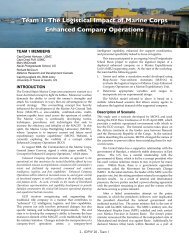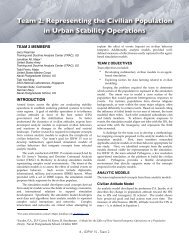pdf file - SEED Center for Data Farming - Naval Postgraduate School
pdf file - SEED Center for Data Farming - Naval Postgraduate School
pdf file - SEED Center for Data Farming - Naval Postgraduate School
You also want an ePaper? Increase the reach of your titles
YUMPU automatically turns print PDFs into web optimized ePapers that Google loves.
The space-filling feature of Nearly Orthogonal Latin<br />
Hypercube (NOLH) enables efficient exploration of the<br />
solution space represented by measures of effectiveness<br />
(MOEs). An NOLH experimental design will facilitate a<br />
comprehensive analysis of potential explanatory variables<br />
within our model. Rather than being restricted to two or three<br />
levels, the analyst can create a design that uses multiple levels<br />
or even a continuous range of values <strong>for</strong> each factor.<br />
In addition to the space-filling property, orthogonal<br />
designs have no linear relationship between the regressors.<br />
The NOLH technique minimizes the correlation between<br />
factor columns, creating a nearly orthogonal design matrix.<br />
We can examine the off-diagonal elements within the<br />
correlation matrix of the design in order to measure the level<br />
of orthogonality.<br />
Using the NOLH designs spreadsheet tool developed by<br />
Professor Susan M. Sanchez at the <strong>Naval</strong> <strong>Postgraduate</strong> <strong>School</strong>,<br />
we generated 257 design points consisting of 23 factors. Our<br />
preliminary design consists of a 257 x 23 matrix with the<br />
largest correlation of 0.089.<br />
This design is displayed in Figure 5 which represents the<br />
space-filling, two-dimensional projections <strong>for</strong> the first four<br />
notional factors.<br />
Figure 5. Scatterplot Matrix of NOLH Design <strong>for</strong> Four Factors.<br />
SUMMARY<br />
Analysis of Base Case<br />
The outputs of interest consist of the possible sensor<br />
system allocations <strong>for</strong> a given CBP concept of operation. The<br />
outputs are highly multivariate, consisting of all sensor<br />
systems positions, dispositions, and strengths as well as the<br />
perception of tunnel location. That is, the output is a Common<br />
Operational Picture (COP) comprised of the adversary and/or<br />
CBP tunnel interdiction assets. The MOEs that may be derived<br />
from ABM include; time, assets and money allocation. In this<br />
manner we determine the constraints that will drive a future<br />
response.<br />
Further Work<br />
The challenges to tunnel defeat are attributed to the vast<br />
lengths of the border, varied geologies that degrade persistent<br />
monitoring and geophysical resolution of subsurface<br />
anomalies, as well as the unknown quantity of existing<br />
tunnels. The tunnel denial and defeat mission must be<br />
addressed in a comprehensive manner in order to be<br />
successfully implemented. This means embracing a<br />
heterogeneous system of systems approach that allows both<br />
passive and active sensing, command and control, and<br />
robotics <strong>for</strong> post discovery interrogation. Be<strong>for</strong>e committing to<br />
a particular technical solution, a cost-benefit study and an<br />
analysis of systems study that takes into account operational<br />
per<strong>for</strong>mance associated with GIS locations, risk assessment<br />
associated with GIS location, man power requirements,<br />
projected training, maintenance costs, and sustainability<br />
factors will provide the necessary oversight and will<br />
demonstrate due diligence in specifying a system solution.<br />
Within the context of systems engineering and analysis,<br />
agent-based modeling <strong>for</strong> tunnel detection systems shows<br />
great promise as a method to enhance the evaluation of<br />
multiple detection systems under various conditions. In<br />
addition, further work may include developing and testing a<br />
DOE capability and designing a user interface appropriate to<br />
the skill level of the operator, the required response times, the<br />
resource allocations, and the operational environment.<br />
Improved automation of output analysis is also desirable,<br />
especially <strong>for</strong>matting the output reports to be more amenable<br />
<strong>for</strong> use by statistical packages <strong>for</strong> data analysis, evaluation,<br />
and assessment.<br />
REFERENCES<br />
[1] US NORTHCOM’s Rapid Reaction Tunnel Detection<br />
(R2TD) Implementation Directive, FY10-12 Joint<br />
Capability Technology Demonstration, 15 March 2010.<br />
[2] Huynh, T.V. and J.S. Osmundson. An integrated<br />
Systems Engineering Methodology <strong>for</strong> Analyzing<br />
Systems of Systems Architectures.<br />
[3] Huynh, T.V. and J.S. Osmundson. A Systems<br />
Engineering Methodology <strong>for</strong> Analyzing Systems of<br />
Systems Using the Systems Modeling Language<br />
(SysML).<br />
[4] Cioppa, T. M. and T. W. Lucas. 2006. Efficient nearly<br />
orthogonal and space-filling Latin hypercubes.<br />
Technometrics.<br />
[5] Sanchez, S. M. 2006. Work smarter, not harder:<br />
Guidelines <strong>for</strong> designing simulation experiments.<br />
Proceedings of the 2006 Winter Simulation Conference,<br />
eds. L. F. Perrone, F. P. Wieland, J. Liu, B. G. Lawson, D.<br />
M. Nicol, and R. M. Fujimoto, <strong>for</strong>thcoming, Piscataway,<br />
NJ:.Institute of Electrical and Electronic Engineers.<br />
49 - IDFW 20 - Team 13




